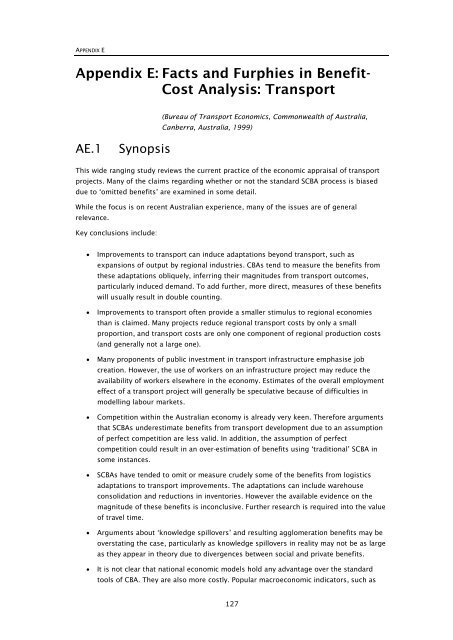Research 350 - NZ Transport Agency
Research 350 - NZ Transport Agency
Research 350 - NZ Transport Agency
You also want an ePaper? Increase the reach of your titles
YUMPU automatically turns print PDFs into web optimized ePapers that Google loves.
APPENDIX E<br />
Appendix E: Facts and Furphies in Benefit-<br />
Cost Analysis: <strong>Transport</strong><br />
(Bureau of <strong>Transport</strong> Economics, Commonwealth of Australia,<br />
Canberra, Australia, 1999)<br />
AE.1<br />
Synopsis<br />
This wide ranging study reviews the current practice of the economic appraisal of transport<br />
projects. Many of the claims regarding whether or not the standard SCBA process is biased<br />
due to ‘omitted benefits’ are examined in some detail.<br />
While the focus is on recent Australian experience, many of the issues are of general<br />
relevance.<br />
Key conclusions include:<br />
• Improvements to transport can induce adaptations beyond transport, such as<br />
expansions of output by regional industries. CBAs tend to measure the benefits from<br />
these adaptations obliquely, inferring their magnitudes from transport outcomes,<br />
particularly induced demand. To add further, more direct, measures of these benefits<br />
will usually result in double counting.<br />
• Improvements to transport often provide a smaller stimulus to regional economies<br />
than is claimed. Many projects reduce regional transport costs by only a small<br />
proportion, and transport costs are only one component of regional production costs<br />
(and generally not a large one).<br />
• Many proponents of public investment in transport infrastructure emphasise job<br />
creation. However, the use of workers on an infrastructure project may reduce the<br />
availability of workers elsewhere in the economy. Estimates of the overall employment<br />
effect of a transport project will generally be speculative because of difficulties in<br />
modelling labour markets.<br />
• Competition within the Australian economy is already very keen. Therefore arguments<br />
that SCBAs underestimate benefits from transport development due to an assumption<br />
of perfect competition are less valid. In addition, the assumption of perfect<br />
competition could result in an over-estimation of benefits using ‘traditional’ SCBA in<br />
some instances.<br />
• SCBAs have tended to omit or measure crudely some of the benefits from logistics<br />
adaptations to transport improvements. The adaptations can include warehouse<br />
consolidation and reductions in inventories. However the available evidence on the<br />
magnitude of these benefits is inconclusive. Further research is required into the value<br />
of travel time.<br />
• Arguments about ‘knowledge spillovers’ and resulting agglomeration benefits may be<br />
overstating the case, particularly as knowledge spillovers in reality may not be as large<br />
as they appear in theory due to divergences between social and private benefits.<br />
• It is not clear that national economic models hold any advantage over the standard<br />
tools of CBA. They are also more costly. Popular macroeconomic indicators, such as<br />
127
















